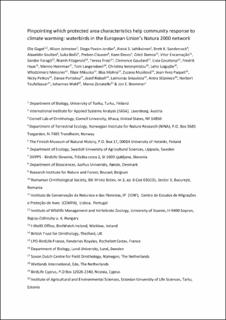Protected area characteristics that help waterbirds respond to climate warming
Gaget, Elie; Johnston, Alison; Pavòn-Jordàn, Diego; Lehikoinen, Aleksi S.; Sandercock, Brett; Soultan, Alaaeldin; Božič, Luka; Clausen, Preben; Devos, Koen; Domsa, Cristi; Encarnaçao, Vitor; Faragó, Sándor; Fitzgerald, Niamh; Frost, Teresa; Gaudard, Clemence; Gosztonyi, Lívia; Haas, Fredrik; Hornman, Menno; Langendoen, Tom; Ieronymidou, Christina; Luigujõe, Leho; Meissner, Włodzimierz; Mikuska, Tibor; Molina, Blas; Musilova, Zuzana; Paquet, Jean-Yves; Petkov, Nicky; Portolou, Danae; Ridzoň, Jozef; Sniauksta, Laimonas; Stīpniece, Antra; Teufelbauer, Norbert; Wahl, Johannes; Zenatello, Marco; Brommer, Jon E.
Peer reviewed, Journal article
Accepted version

Åpne
Permanent lenke
https://hdl.handle.net/11250/3014174Utgivelsesdato
2021Metadata
Vis full innførselSamlinger
- Publikasjoner fra CRIStin - NINA [2364]
- Scientific publications [1392]
Originalversjon
10.1111/cobi.13877Sammendrag
Protected area (PA) networks facilitate community changes in response to climate warming. However, the contribution of the site characteristics are not well understood. Here, we investigate how composition of non-breeding waterbird communities within the Natura 2000 (N2K) network changes in response to increases in temperature. We measured the community reshuffling of 97 waterbird species in 3,018 N2K sites over 25 years in 26 European countries. We find that N2K sites explicitly designated for protection of waterbirds and with a management plan had faster climate-driven community changes. In contrast, the designation period of the PA was not associated with community adjustment, and PAs funded under EU-LIFE had lower climate-driven community changes. Our findings imply that efficient conservation policy that may help a target community adjust to climate warming is to manage sites that are specifically designated for that target community. EU Birds Directive, climate adaptation, colonization, conservation policy, distribution change, LIFE programme, wetland